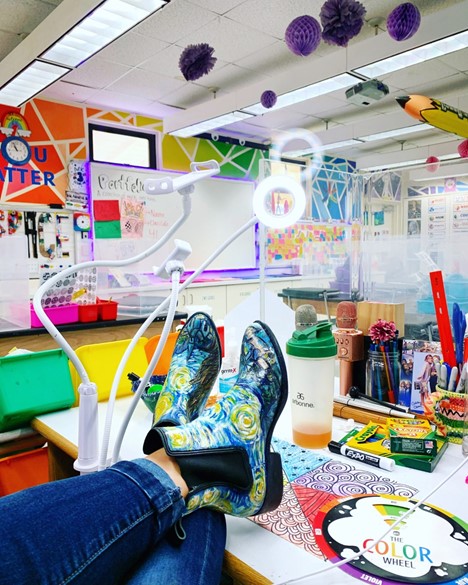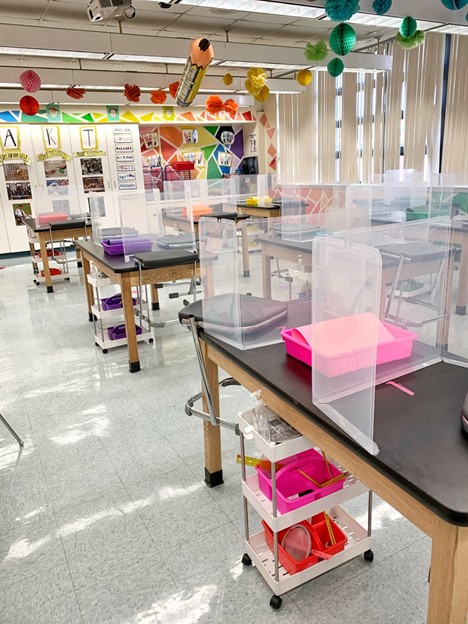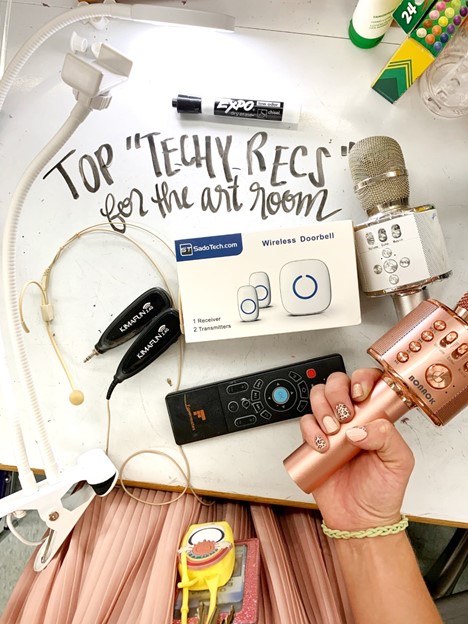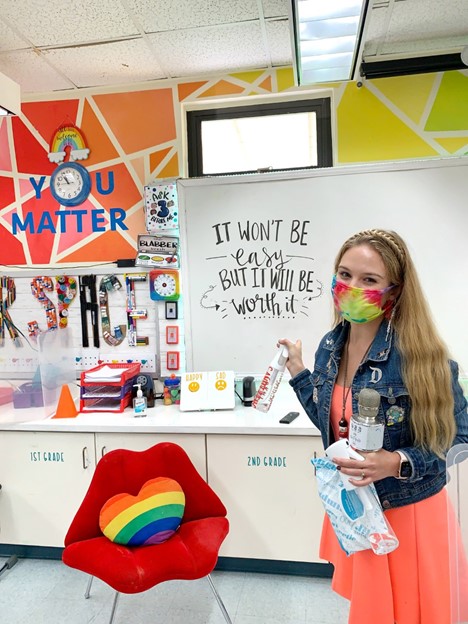Back to School in a Pandemic
I won’t sugar coat it—teaching is hard, and teaching during a pandemic is even harder. Art teachers and students everywhere are finding themselves in unique and challenging situations—some teaching and learning online, some in person, some traveling on a mobile “art cart”, and some are teaching in all of these settings at once. No matter what your teaching or learning situation is, one thing is clear—we all need art now more than ever.
Here, I list my top 10 tips to keep creating and creating safely!

1. Stay Positive. This may seem like a cliché- but the #1 thing teachers and students need to do right now is take care of themselves! This may not be the year that you host or participate in several art shows, and that’s okay. I’m finding myself saying “no” to the things that won’t benefit myself or my students in order to allow time to prioritize the things that will.
2. Be flexible and don’t finalize any plans. Yes, that means even your school schedule. Consider writing in your planner with pencil. Many schools are constantly flipping from one model of learning to another. Whether you started out virtual, face-to-face, or hybrid—it can all change with little notice. I personally have trouble handling surprises and last-minute changes, so I am trying my best to have a positive attitude and be flexible when I can. Typically, my Type-A personality has me creating color-coded rosters and seating charts the first week of school. Now, we are in our second month of school and I haven’t made my permanent rosters or seating charts yet because students are coming and going from virtual to in-person classes.
3. Take advantage of technology. This year, consider a flipped classroom approach to teaching that accommodates both virtual and in-person learners. I film all of my lessons and demonstrations using a gooseneck tripod or phone stand, edit them on iMovie, and upload them to YouTube. This way I can double myself for face-to-face and virtual learners while also allowing for more time to set up, clean, sanitize, and even assist students as the video is playing. In both cases, I am actively teaching and engaging my students, often pausing my videos to interject and discuss with them. The video format allows me to do this without losing track of our goals for the day. A flipped classroom is also a great time management tool. You don’t have to be extremely tech savvy to do it either! I learned the basics of iMovie during my time at the University of Florida and have been using them ever since. It takes practice—your first videos may not be perfect, but your voice will thank you, as will your sanity.

4. Work on personal growth and goals. Spend time with family, work on your own artwork, and even consider starting online courses for professional development. Before the pandemic, I had such a busy in-person schedule that I was hardly on my computer, but now, I’m at home working more often than not. It may be the perfect time to think about getting your master’s. The University of Florida’s M.A. in Art Education program is flexible and adaptable to your life and schedule.
5. If you need help, ask for it. Educators are here for their students and for each other at this time. I personally struggle to find my voice when it comes to asking for help. I have only been teaching for four years, and this voice gets a little louder each year as I learn that I don’t need to do everything on my own. Whether it’s funding art supplies for my students or asking how to further my education—just do it! Asking for help when you need it will only benefit yourself and your health, both mentally and physically. It is crucial that we do everything we can to stay healthy right now. Again, this sounds like a cliché. “Stay healthy” in a pandemic? Yes—you can do things with big results that will benefit your immune system. Aside from asking for professional help, self-care items like meal prepping healthy lunches for the school days, turning off the notifications and alerts from virtual learners after hours, and getting that much needed sleep! Your future self will thank you.
6. Don’t compare yourself to others. Whether you are a student or a teacher, this is important but not easy to accomplish. I am constantly having to remind myself that social media is a highlight reel. When the idea of having to teach art on a cart was first introduced to me, I took to Instagram and Pinterest to find the snazziest looking carts out there. I was determined to have the best one if I was going to have to be on wheels. I even tried to fundraise for my $600 “dream cart” and planned on purchasing it with my supply budget if I couldn’t reach my goal. Soon after I began fundraising, a family member offered a free cart to me. I accepted their offer and fixed it up to make it work. I am so relieved that I didn’t spend all of the extra money and energy on the shiny new cart because I didn’t even end up having to teach on a cart this year. As much as we want to be prepared, sometimes you just don’t know what’s coming. Again, be flexible. I’m trying my best to go with the flow. I am now using my art cart to sort and sanitize supplies!

7. Cleanliness is key. This one may not apply for those learning and teaching from home as much, but, for me, this is a biggie. My school doesn’t regulate what to do in terms of supplies in the art room—they just encourage us to follow the CDC guidelines that state students should not share supplies, and they should use individual, sanitized supplies. I decided that I wanted my students to get to use the wide variety of materials that I introduce to them throughout the year. As an elementary art teacher, seeing the joy on students’ faces as they create a watercolor resist for the first time or learn to make a pinch pot is pure magic. I get as much out of the experience as they do—I feed off of my students’ energy! That being said, I really wanted students to use my art supplies instead of bringing in their own, even if it meant having to sanitize my supplies ten times a day. So, I came up with a routine. Each grade level/class uses different materials for different projects each week. I separate the supplies into individual containers for each student. They sanitize their hands before and after use and even wipe down the supplies and their area before they leave. After class, I put all the used supplies into a “dirty” container to be deep cleaned and sanitized at the end of the day.
8. Gather these “must-haves.” For the past three years, my number one recommendation for art teachers is to purchase a gooseneck tripod. They are around $20, and if you purchase a good one, it should last for years on end. Now that I am teaching virtually, I find myself increasing my use of it, and I even purchased better lighting. Ever wonder how people on social media look so good? It’s usually thanks to a light ring. While this is totally unnecessary to provide an art education, it’s certainly beneficial and fun, even just for a boost of self-confidence while making videos!

9. Stay connected. No, I don’t mean spend more time on your phone or social media… but I do mean schedule your regular meetings with colleagues over Zoom. I recently had the pleasure of joining in on two Zoom classes with UF School of Art + Art History professors and students. I loved getting a peek into the current online programs and seeing students actively creating in their own homes while sharing it, just as if they were in their campus studios. They have been able to create the same tight-knit relationships virtually, challenging each other and sharing their ideas. Being an art teacher (and an artist in general) can get lonely, especially if you are the only one in your living space. I find talking to other art teachers and students to be extremely comforting. Finding “your people” to relate to is always important, but especially now! If that means going back to school, so be it! Take the leap.
10. Keep creating. There is so much going on in the world right now—from social unrest, to politics and the upcoming election, to the COVID-19 pandemic—there is a lot of basis to create upon here! Make the time to create. I love that UF master’s in art education courses involve their students in studio work on top of education, philosophy, and pedagogy. Sometimes all it takes is a group of artists encouraging you to believe in yourself and your purpose as an artist, educator, and human being.
I’m doing the best I can to follow my own advice, but here I am writing this on a few hours of sleep while simultaneously trying to make a lesson plan. I’ll admit that it’s hard. If my students take away one thing from my classroom, I hope that it’s believing in themselves and their ability to learn. Adults need that reminder too.
Stay well and keep on creating!
Kelsi Quicksall
Art Teacher
Osceola Elementary School in Ormond Beach, Florida
UF Art Ed Alumna Spring ’17
Request Information
To learn more about University of Florida’s online Master of Arts in Art Education download a brochure, fill out the fields below or call us at (352) 662-3395 to talk with one of our enrollment specialists.



